核与辐射前沿技术研究中心(以下简称前沿中心)是中国辐射防护研究院下设的二级机构,主要从事高灵敏放射化学分析、新型辐射探测与成像技术、智能辐射防护技术方面的基础研究与技术开发工作。

图1 加速器质谱质谱分析实验设施
Fig 1 Experimental facilities for accelerator mass spectrometry mass spectrometry
前沿中心下设放射化学分析研究室、加速器质谱应用研究室、核辐射探测与成像应用研究室、智能辐射防护技术研究室,主要研发工作包括:环境和生物样品中难测β和α放射性核素的放化分离与分析技术研发;高灵敏质谱分析技术及其在辐射防护、环境、医学等领域的应用研究;辐射探测器、探测方法学及其在成像方面的应用研究;医学物理、人工智能与电子器件辐照效应等技术研发。
1、放射化学分析实验室
致力于快速、灵敏的难测放射性核素分析方法研发及其应用研究。主要从事放射性核素(放射性锶、55Fe、63Ni、210Pb、210Po、镭同位素、32P、14C和锕系核素)放化分离及测量技术研究和有机闪烁材料(国产闪烁液、闪烁树脂)研发。
● 设备
配有放射化学综合分析实验室,拥有TDCR 液闪计数器、超低本底液闪计数器、alpha谱仪、便携式X荧光衍射仪等分析仪器,及完善的样品预处理设备。
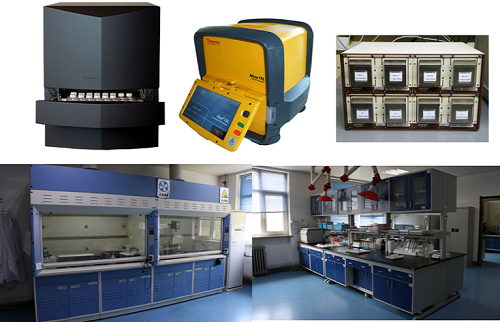
图2 放射化学综合分析实验室及仪器设备
Fig2 Facilities and equipment in the radiochemistry analysis laboratory
● 技术及应用
◎核电废物(液态流出物、废树脂、废机油)中55Fe、63Ni和90Sr分析方法
※处理量:8个样品/批次,3小时;
※检测限:55Fe:0.084 Bq;63Ni:0.164 Bq;90Sr:0.06 Bq;
◎生物样品(血液和尿样)中32P和90Y快速分析方法
※处理量:无需化学分离操作,40个样品/批次,3小时;
※检测限:32P:0.055 Bq;90Y:0.3 Bq(测量时间5分钟);
◎环境样品中210Po和210Pb分析方法
※处理量:210Po:微沉淀技术,24个样品/批次,5小时;210Pb:4个5 L水样品/批次,4个小时;
※检测限:210Po:mBq水平;210Pb:0.08 Bq
◎尿素[14C]胶囊中14C的鉴别及放射性核纯度分析方法
※可满足中国药品监督管理局关于尿素[14C]胶囊的质量要求
◎有机闪烁材料
※ 国产闪烁液
※闪烁微球
● 放射性核素分析技术培训
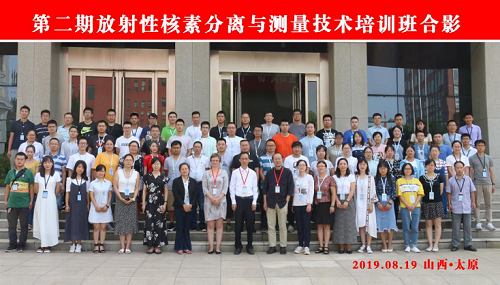
图3 放射性核素分离与测量技术培训班
Fig3 Radioanalytical chemistry training activities
2、加速器质谱应用实验室
加速器质谱应用研究室配备0.35 MV多核素加速器质谱仪(Multi-isotope Low Energy AMS—MILEA)、多重串联电感耦合等离子体质谱仪(ICP-QQQ)、alpha谱仪及液体闪烁计数器等设备,并在此基础上建立了完善地超低水平放射性核素放射化学分析能力。截至目前,该研究团队已具备针对多样介质(生物和环境样品)中难测α、β放射性核素的超灵敏分析测试能力(锕系核素、C-14、I-129、Tc-99、Cs-135、Sr-90等),其技术指标已达到国内领先,国际先进水平。本研究团队针对生物医学、环境科学、辐射防护、核科学领域等多学科交叉的研究热点和前沿问题中的超灵敏分析技术需求,开发并提供以上相关领域科研应用所需要的高效、高灵敏分析技术,促进多学科交叉融合与发展。
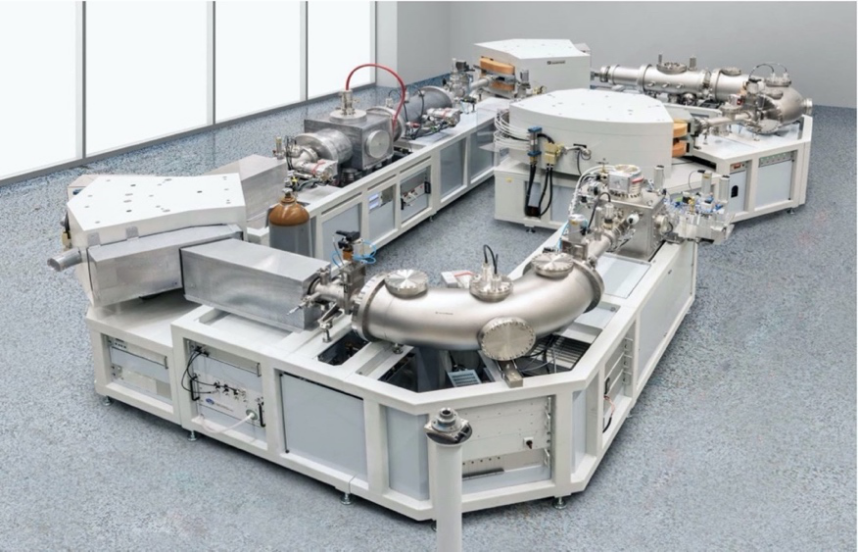
图4 超灵敏小型加速器质谱仪(MILEA)
Fig4 0.35 MV multi-isotope low energy AMS (MILEA)
MILEA结合了MICADAS(专用14C-AMS专用仪器)的加速器和离子源技术以及ETH 600kV TANDY的高能质谱仪技术,能够用于天然长寿命放射性核素(10Be,14C, 26Al ,41Ca, 129I)以及236U、Pu、Np、Am、Cm、Cf等重核素的高灵敏分析。
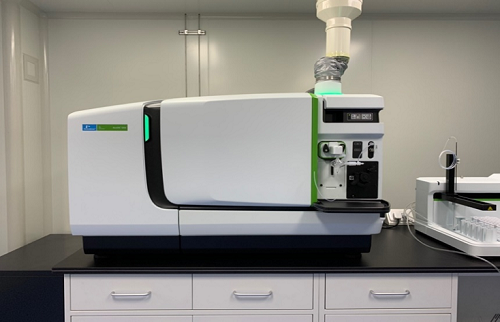
图5 Apex-Omega高效进样器和多重串联电感耦合等离子体质谱仪(ICP-QQQ)
Fig 5 Multi-quadrupole ICP-MS(ICP-QQQ)
3、核探测与成像应用实验室
核探测与成像应用研究室聚焦高分辨率成像探测技术及应用研究,主要研究方向包括微结构冷热中子成像探测器研制、人体实时三维剂量分布测量技术研究等研究。
研究室致力于冷中子无损检测技术的提升,依托特种玻璃研发及测试实验条件,开展微结构冷中子敏感成像闪烁屏及成像探测器研制。所研发的基于掺钆闪烁纤维面板的冷中子成像探测器实现了14.5μm(CTF=0.5)的空间分辨和55%的探测效率,达到国际先进水平。
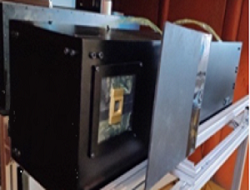
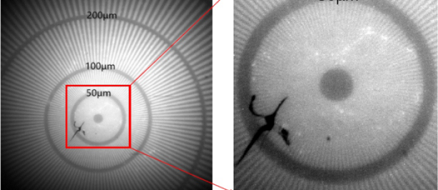
图6 基于掺钆闪烁纤维面板的冷中子成像探测器及分辨率测量结果
Fig 6 Cold neutron imaging detector based on Gadolinium scintillation fiber array and spatial resolution testing results
研究室瞄准放疗过程中的精准剂量验证展开研究,自主研发了 γ软组织等效性优于5%,发光强度达到Hisafe液闪的 80%的组织等效闪烁材料,并基于此开展实时高分辨的三维受照剂量测量技术研究。
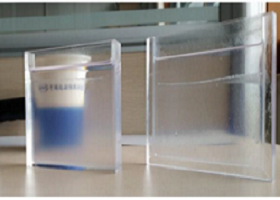
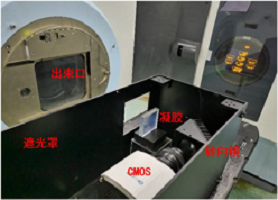
图7 组织等效闪烁材料及实时剂量测量装置
Fig7 Tissue-equivalent scintillation material and real-time dose measuring device
4、智能辐射防护技术实验室
智能防护技术研究室致力于将人工智能技术和辐射防护实践相结合,推动辐射剂量学、辐射防护最优化、电子器件辐照效应等领域的技术进步,探索人工智能时代的一体化辐射防护解决方案。
● 研究方向
◎智能辐射防护:将智能算法与γ能谱测量、辐射防护数据分析相结合,现主要开展4D人员外照射剂量监测、γ能谱智能分析、核设施大数据挖掘、辐射防护方案智能决策、染色体异常智能识别等技术研究。
◎器件辐照效应:面向核工业智能装备耐辐射需求,主要开展电机驱动器、摄像头等典型机电模块的加固设计、器件辐照失效机理研究、复杂系统耐辐照可靠性评价等技术研究。
● 应用
◎人员动态剂量实时监测系统:已初步建立基于动作捕捉和GPU加速计算的人员动态剂量实时监测系统,可应用于核设施集体剂量监测与介入职业人员剂量监测。
◎数据可视化系统:已初步建立基于OLAP技术的核设施辐射防护大数据可视化与在线交互分析系统,已在国内核电厂取得应用。
◎电子器件耐辐照性能测试:已建立相对完善的总剂量效应研究和试验体系,可提供包括被试品调试、测试系统开发、γ辐照测试、中子辐照测试等环节的器件耐辐照性能测试技术服务。
◎电子器件辐照效应数据库:已建立面向核工业的器件辐照效应数据库,涵盖智能装备常用的10大类器件,包含总剂量、单粒子、位移损伤等三种常见的辐照效应数据。
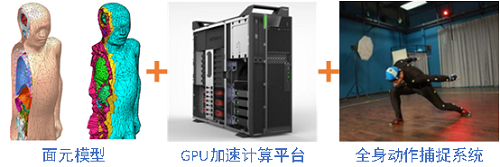
图8 4D剂量高速计算平台
Fig8 4D external dose evaluation platform
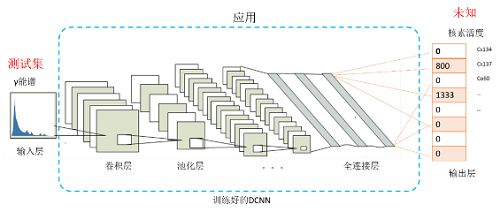
图9 基于DCNN的γ能谱快速分析技术
Fig 9 Fast analysis of gamma-ray spectrum based on DCNN
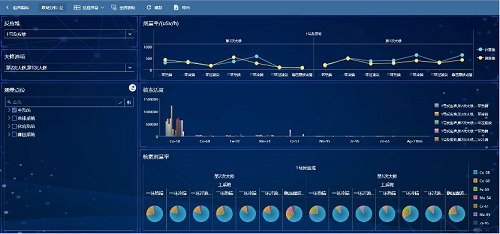
图10 大数据可视化与在线交互分析系统
Fig 10 Big data visualization system
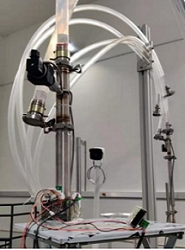
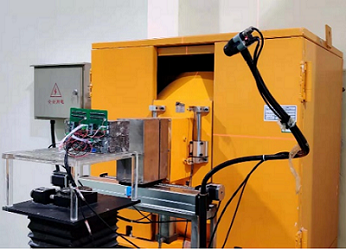
图11 电子器件总剂量效应及单粒子效应测试
Fig 11 Electronics radiation effects evaluation
As a part of the China Institute for Radiation Protection, the Nuclear and Radiation Technology Frontier Center (NRTFC) was founded in 2014. Four laboratories have been set up in the Nuclear and Radiation Technology Frontier Center, including Radiochemistry Analysis Laboratory, Accelerator Mass Spectrometry (AMS) Application Laboratory, Nuclear Detection and Imaging Application Laboratory, Intelligent Radiation Protection Laboratory. Research and development topics in the center including: radioanalytical methods for the hard to detect alpha and beta nuclides, highly sensitive mass spectrometry technology and its application in the field of radiation protection, environmental and medical science, nuclear radiation detectors and methodology in nuclear imaging science, medical physics, artificial intelligent and the evaluation of radiation effects on electronic devices.
1、Radiochemistry Analysis Laboratory
The Radiochemistry analysis laboratory is skilled in development and application of rapid and sensitive method for determining hard detectable radionuclides. Major in developing radiochemical separation and measurement technique of radionuclides, such as radio strontium, 、55Fe、63Ni、210Pb、210Po,radium isotopes, 32P、14Cand actinides, and organic scintillation material (liquid scintillation cocktail, plastic scintillation microspheres)
● Instrument
Department of Radiochemistry analysis has a radiochemical analysis laboratory, equipped with analytical instruments, such as TDCR liquid scintillation counter, ultra-low background liquid scintillation counter, alpha spectrometer, portable X-Ray fluorescence instrument, as well as sample pre-treatment equipment.
● Technique and Application
◎ Method of determination for 55Fe、63Ni和90Sr in Nuclear power waste (liquid effluent, waste resin, waste engine oil)
※ Sample throughput: 8 samples per batch in 3 hours;
※ Minimum detectable activity: 55Fe:0.084 Bq;63Ni:0.164 Bq;90Sr:0.06 Bq;
◎ Rapid screening method for32P and90Y in Biological samples (blood and urine samples)
※ Sample throughput: no need of radiochemical separation, 40 samples per batch in 3 hours;
※ Minimum detectable activity:32P:0.055 Bq;90Y:0.3 Bq
◎ Method of determination for210Po and210Pb in environmental samples
※ Sample throughput:210Po micro-precipitation, 24 samples per batch in 5 hours; 210Pb: four 5 L-drink water samples per batch in four hours;
※ Minimum detectable activity:0.08 Bq;
◎ Method of radionuclide identification and radionuclide purity of 14C in urea[14C] capsules
※ Meet the quality requirements of National Medical Products Administration on urea [14C] capsules
◎ Organic scintillation material
※ Domestic liquid scintillation cocktail
※ plastic scintillation microspheres
◎ Raining of radionuclides analysis technique
2、Accelerator Mass Spectrometry Application Laboratory
The accelerator mass spectrometry (AMS) application laboratory is equipped with 0.35 MV multi-isotope low energy AMS (MILEA), multi-quadrupole inductively coupled plasma mass spectrometry (ICP-QQQ), alpha spectrometry and liquid scintillation counter (LSC), etc. Multiple ultra-sensitive analysis technologies of α and β radionuclides (actinides, C-14, I-129, Tc-99, Cs-135, Sr-90, etc.) in various biological and environmental samples have been developed, and has reached the world"s advanced level. The laboratory aims to develop and provide highly sensitive analytical technologies for the research applications in the fields of biomedical science, environmental science, radiation protection, nuclear science and other interdisciplinary hot spots and frontier problems, so as to promote the integration and development of multi-disciplines.
MILEA introduction
MILEA combines the technology of accelerator and ion source of MICADAS (dedicated C-14-AMS dedicated instrument) and the high-energy mass spectrometer technology of ETH 600kV TANDY, which can be used for the ultra-sensitive analysis of natural long-life radionuclides (Be-10, C-14, Al-26, Ca-41, I-129), U-236, Pu, Np, Am, Cm, Cf and other heavy radionuclides.
ICP-QQQ introduction
The PerkinElmer NexION 5000 multi-quadrupole ICP-MS is innovatively designed to meet the demanding requirements of ultra-trace elemental applications. It provides the best ion beam control within this instrument class and is capable of suppressing and eliminating spectral interferences in complex samples, ensuring the best background counts in both hot and cold plasma conditions and outstanding detection limits.
3、Nuclear Detection and Imaging Application Laboratory
The Nuclear Detection and Imaging Application  Laboratory (NDIAL) focuses on high-resolution imaging detection technology and application. The main research directions include the development of structured cold neutron imaging detectors, 3D dose distribution measuring technique for
Laboratory (NDIAL) focuses on high-resolution imaging detection technology and application. The main research directions include the development of structured cold neutron imaging detectors, 3D dose distribution measuring technique for  radiation therapy and other directions.
radiation therapy and other directions.
Our laboratory is committed to the improvement of neutron nondestructive testing technology. Micro-structure cold neutron sensitive scintillation screens and imaging detector were developed based on special glass research and development facilities. The cold neutron imaging detector based on Gadolinium scintillation fiber array achieves a spatial resolution of 14.5μm (CTF=0.5) and a detection efficiency of 55%, reaching the international advanced level.
The laboratory aims at the accurate dose verification in the radiation therapy, and independently developed a tissue-equivalent scintillation material with a γ soft tissue equivalence of 5% and its light yield reached 80% of Hisafe. Real time, 3D Dose distribution measuring technique for radiation therapy are in research and development.
4、Intelligent Radiation Protection Laboratory
The Intelligent Radiation Protection Laboratory works to provide the integrated radiation protection solution in the age of AI by merging intelligent algorithms with radiation dosimetry, ALARA practice, medical physics, and electronics radiation effects.
● Research Interests
Intelligent radiation protection: By combining intelligent algorithms with gamma-ray spectrum measurements and radiation protection data analysis, currently, we focus on the 4D external dose evaluation, fast analysis of gamma-ray spectrum, nuclear facility data mining, autonomous decision making system, and chromosomal abnormality diagnosis.
◎Electronics radiation effects: To meet the demand of nuclear intelligent equipment development, currently, we focus on the radiation hardened design of motor driver and industrial camera, radiation effects on novel semiconductors, and the radiation reliability analysis of the complex system.
◎Medical physics: To meet the demand of precise dose control and dose validation in radiotherapy, currently, we focus on ultra-high dose rate radiotherapy, CT dose evaluation, TAT dose distribution, and TPS optimization.
● Application
◎Real-time 4D personnel external dose monitoring system: We propose a novel real-time personnel external dose monitoring technology by the integration of motion capture and GPU-accelerated Monte-Carlo simulation.
◎ Big data visualization system: We provide a big data visualization and online interactive analysis platform based on the OLAP technology. Such platform has been applied in several NPPs.
◎ Radiation testing of EEE parts: We provide terrestrial radiation testing services which include test samples preparation, program and test board development, the TID and SEU testing as well as results reporting.
◎ EEE parts radiation database: A database of electronic components radiation testing results, covering 10 major types of devices, the total ionizing dose effects reports, the single event effect reports, and the displacement damage reports.

中国辐射防护研究院公众号

手机版